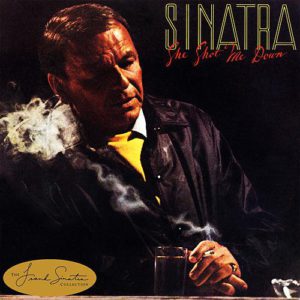The decadent arrangement of “The Gal Who Got Away” and “It Never Entered My Mind” first sung by Frank Sinatra in the early 1980s, is perhaps the greatest fusion chart ever created for a singer of American standards. Combining a stomping orchestral chart by Nelson Riddle with some tasty intricate solo piano played by Sinatra sideman Vincent Falcone, the arrangement was the final selection on the brief but memorable Sinatra album “She Shot Me Down,” finally brought to the ears of listeners after nearly a decade of stops and starts in July 1981. The album recently celebrated its thirty-sixth anniversary, and is deserving of an honorable mention. With the exception of the “Duets” albums of the 1990s, “She Shot Me Down” is the next to last solo album produced for Sinatra’s label, Reprise Records.
The album consists of nine songs, a lavish, somewhat bleak orchestral package of seven selections orchestrated by longtime Sinatra collaborator Gordon Jenkins, bookended at the close by the aforementioned Riddle arrangement, and opened with a Don Costa treatment of a song written by Stephen Sondheim for his recent musical “Merrily We Roll Along,” the somewhat sad tune “Good Thing Going,” about the ending of a relationship. While this makes for a somewhat uneven listening experience, Sinatra’s performances, without a doubt the finest torch song readings he had done in many years, put the variances in background quality aside.
The overall concept of the album harkens back to two earlier albums Sinatra worked on with Jenkins at the close of the Capitol era in the late 1950s, “Where Are You?” and “No One Cares,” with dark, brooding, some would say suicidal musical backgrounds accompanying Sinatra as he tells his tale of woe and heartbreak through a devised program of saloon songs. Sinatra had planned this album in advance for many years, having the name “She Shot Me Down” in place as the title, after a sorrowful Jenkins’ arrangement of Sinatra’s daughter Nancy’s hit song “Bang Bang, My Baby Shot Me Down,” which the singer would cover for the album.
Following the release of the 1973 and 1974 albums “Ol’ Blue Eyes Is Back” and “Some Nice Things I’ve Missed,” this saloon album project was the next to be completed on the docket. However, due to mixed reactions by both critics and audiences alike to the two released albums, coupled with a hectic tour schedule, Sinatra put the album on the back burner for a long time. He would begin and complete the much-touted “Trilogy” album in the late 1970s with the saloon project still in waiting, but with the turning of the decades and a substantial decline in the health of Gordon Jenkins, Sinatra then made the album a priority, wanting to finish it before his friend and arranger left the world for good. Jenkins would later pass away in 1984.
Accompanying “Bang Bang” in the musical program were the songs “Hey Look, No Crying,” “South To A Warmer Place,” “Monday Morning Quarterback,” “Thanks For The Memory,” “A Long Night,” and the beautiful “I Loved Her,” which Sinatra featured on his 1981 television special “The Man And His Music.” While many agree that the deterioration of Sinatra’s vocal cords were well underway by this point in his career, his voice however was well-suited for the type of mood the album projects. To paraphrase a quote by Quincy Jones, while Sinatra may have been losing the top notes in his vocal register by this time in the 1980s, he was gaining a few more on the lower end of the scale. The transposition makes for a stirring, moving listening experience.
Even more unique was the album cover, featuring a classic stance of the singer standing behind a bar with a glass of Jack Daniels and ashtray in the foreground, with a lit cigarette trailing wispy smoke into the air before a eyes-closed Sinatra, pensively contemplating his next move. He wears a black button down jacket, nearly hiding a yellow sweatshirt underneath. The shirt read, as seen in other photos, “Ol’ Blue Eyes Is Back.” The photo was taken during rehearsals for his 1973 television show and would obviously promote the saloon album when he started planning it in 1974. Sinatra apparently stuck to his guns and used the same image he planned to all along when he finally got the album going in 1981.
That’s one thing about Sinatra that is always evident; when you got him going on an idea, he didn’t often let it fall by the wayside.
Until next time, Sinatra lovers!
Jerry Pearce is an amateur singer in the vein of Frank Sinatra, Perry Como, and Dick Haymes and has released two discs of standards music, Crossroads in 2010, and One Summer Night in 2016. Samples of his music can be heard on his YouTube Channel. To purchase his CDs use the form box below.
[si-contact-form form=’3′]

 August 1st, 2017
August 1st, 2017  CEO
CEO 
 Posted in
Posted in  Tags:
Tags: 



